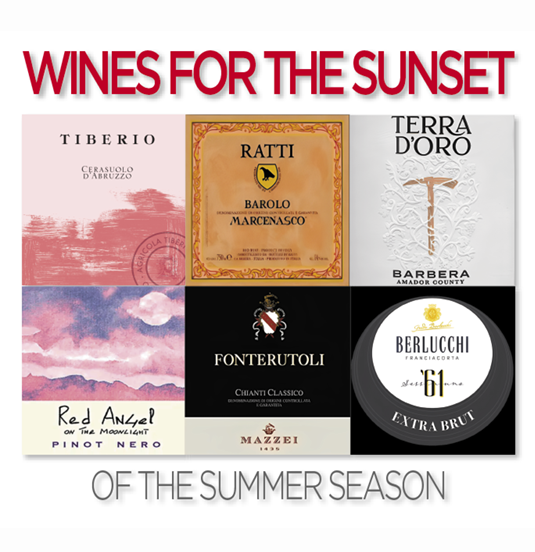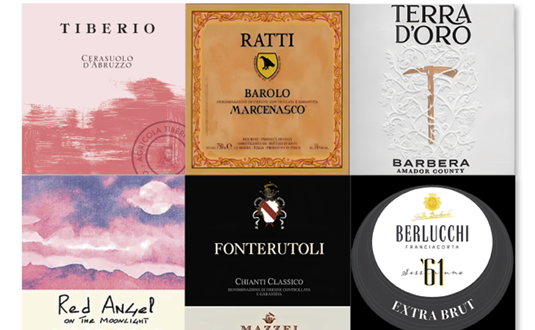WINES FOR THE SUNSET OF THE SUMMER SEASON
 By Seema Tikare
By Seema Tikare
I just spent a glorious 3 weeks in Italy. A week in Milan, a second in Gaiole in Chianti, and a final week in Venice. I had been dreading being in these places in August, thinking of the heat, the crowds, the hassle. But as it turns out, the gods smiled upon us. The temperatures never rose above the low 80s, the crowds were surprisingly sparse, and there was actually very little hassle. It all went beautifully, except that everywhere I went, from lunchtime on, seemingly everyone was drinking Aperol Spritz. I am guessing they were all tourists because Italians have a strict sense of timing. Cappuccino in the morning, espresso (no milk!) after lunch, and Aperol only for an aperitif strictly after 5pm. Unfortunately for me, I do not like Aperol Spritz to drink. To see it, however — that gorgeous light orange color glinting with a few cubes of ice on a hot summer’s evening, a delicious slice of orange floating on top like a little wheel of delight — is to be envious. To taste it, meh, not for me. However, not to be outdone, I decided to try a variety of Italy’s underappreciated wines in a full spectrum of stunning hues. As it turns out, Italy makes an enormous variety of wines that are perfect for a warm summer evening — they shine, but they do not overpower the other flavors you might have with your aperitif, whether it be potato chips or a lovely charcuterie board (“salumi”) with various local meats and cheeses. And these wines can transition beautifully to just about all types of food at the dinner table.
Happily, no longer do European waiters judge if you order a red wine with fish or a white wine with meat. There is a certain cosmopolitan attitude these days that recognizes wine comes in many different styles, making them more interesting and giving in a wider range of colors, aromas, flavor profiles, and pairing possibilities. This also means that these wines can accompany us as we transition gracefully into the cooler days of fall.
2023 TIBERIO CERASUALO D’ABRUZZO, ABRUZZO, ITALY
Cerasuolo (pronounced chair-a-su-o-lo) is made with a high quality, but rare grape called Trebbiano Abruzzese. It is a breathtaking dark pink color that almost looks like a red wine at first glance, but it is a Rosato that spends only minutes on the skins before being very gently pressed off. Tiberio only uses the free run juices from the very gentle first press so that any harsh flavors from the skins and seeds is avoided. These grapes, grown with the utmost care, hail from 350 meters (1150 ft) up the steep hillsides and just barely ripen. This makes it difficult to make a red wine, but it is perfect for a rosé. This wine is a perfect blend of black and blue berries that impart a richness with the refreshing notes of rhubarb, savory spice, and rose petals providing lift and vibrancy. This is a wine that can pair with almost any food, from seafood to duck and even pork.
2020 RENATO RATTI BAROLO MARCENASCO DOCG, PIEDMONT, ITALY
Visiting the cellars of Ratti wines is sublime. Anytime you walk into a winery, that aroma of oak and grape skins and wine makes a heady scent that I would love to bottle and pipe through my house. But the scent of the Nebbiolo grape is incomparable. There is the expected rose petal, dried violets, bursting cherries, but also undertones of licorice and chocolate and tobacco. It is almost enough just to savor that smell. But to miss out on tasting the wine would be a crime. Barolo is considered to be “muscular” because, despite its relatively light color, it is a powerhouse. The attack is full of aromas and flavors with loads of tannins that compress all that power on the palate to bring a punch of flavor and sensation. And the finish is gorgeously complex with lingering notes of cherry, spice, florals and minerals. It is a bit of splurge, but worth it when you are celebrating with grilled game, red meats, and good company.
2022 TERRA D’ORO BARBERA
AMADOR COUNTRY, SIERRA FOOTHILLS, CALIFORNIA
While Terra d’Oro is in California, it is a perfect example of how versatile and delicious Italian varietals are. Long considered a rustic, working man’s wine, Barbera was overlooked on high end restaurant and bar menus for decades. There is finally some recognition that not only can Barbera make world-class wine, but it is also becoming extremely popular with many wine drinkers. There is no doubt that this wine has powerful tannins, very lush round fruit, and is high alcohol at 14.5%. It is not for the faint-hearted, but oddly, it is a great wine that transitions to the fall because it has the juicy, plum and blueberry flavors that pair well not only with a late summer barbeque but also with the roasted butternut squash soups and sweet potatoes that are so delicious in the early fall days. It stands up to foods that are spicy, sweet, rich, as well as tart. It is a surprising chameleon.
2020 JERMANN RED ANGEL ON THE MOONLIGHT PINOT NERO
FRIULI-VENEZIA-GIULIA, ITALY
My first night in Milan this summer, I just could not resist the name of this wine. I had foolishly never tried a Jermann wine before but have corrected that mistake several times over. There is a joy in just saying the name, especially the Pinot Nero di Friuli Venezia Giulia part, as if you are fluent in Italian. On the palate, you get a burst of cherries, strawberries, roses, and violets, spice, and the characteristic savory, herbaceous notes that suffuse European wines. Jermann has been making wine in the region since 1881 when they moved from the Austrian — Slovenian border to Italy, with carefully selected terroir that suits this finicky grape perfectly. The best aspect is that it is lively and refreshing but with enough complexity to go with everything from salmon to lamb. Saluté!
2022 CASTELLO DI FONTERUTOLI CHIANTI CLASSICO DOCG CASTELLINA IN CHIANTI, ITALY
Chianti Classico is not Chianti. I find myself using this refrain too often — apologies. But it is nonetheless true. Chianti is usually seen as the cheap and cheerful wine served in the basket-wrapped flask the Italians call (hilariously) a “fiasco”. Chianti Classico, by contrast, is a stately, historic region in Tuscany that has seen premium wine being made as early as the 1300s. And there is a big difference in quality and style. The Classicos, always stamped with the Black Rooster or Gallo Nero, are grown on soils that are ideal for Sangiovese — a wonderful mix of limestone and clay that create the perfect balance of fruit, acid, and tannins showcased in the wines of this specialized region. And Fonterutoli makes some of the best wines in an already remarkable field of competitors. It is incredibly smooth with gorgeous black and red fruit, hints of cocoa and vanilla, licorice and cedar, tobacco and truffles. It is wine for all seasons, so it helps ease the transition from the lazy, sultry days of summer to the more breezy, blustery days of fall.
NV BERLUCCHI FRANCIACORTA ’61 EXTRA BRUT, BRESCIA, ITALY
There is no “season” for sparkling wine. It is for all seasons and occasions. While Prosecco dominates the market for Italian sparkling wines, Franciacorta is the heavy hitter in terms of quality. This is a region that specifically set out to challenge the supremacy of Champagne — much like the super-Tuscans set out to challenge the supremacy of Bordeaux — and it is possible that they might succeed. Nestled in the foothills of the Dolomites, just above Lake Iseo, this region is warmed by the natural amphitheater of soils at the base of the Alps but cooled by breezes from the lake below and from the mountains above, allowing the grapes to ripen to perfection. The ’61 Extra Brut is a blend of 85% Chardonnay and 15% Pinot Noir that spends 24 months on the lees and rests 2 months after disgorgement before release. It is crisp, rich, and finely balanced with a soft mousse and notes of lemon tart, green apple, and buttered toast. If it is not on the menu of your favorite restaurant, you should ask for it to be added. It is a beautiful accompaniment to any occasion or meal.

